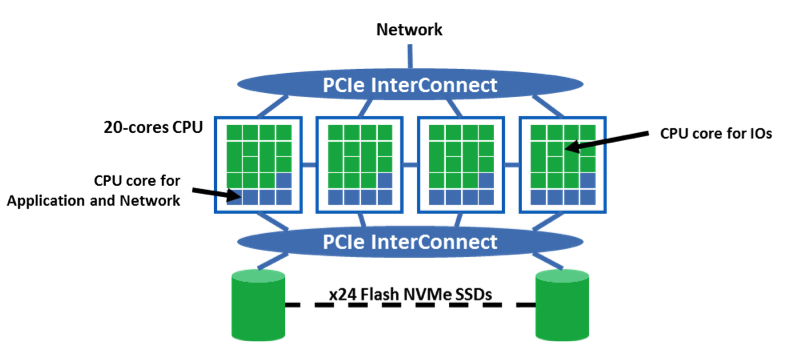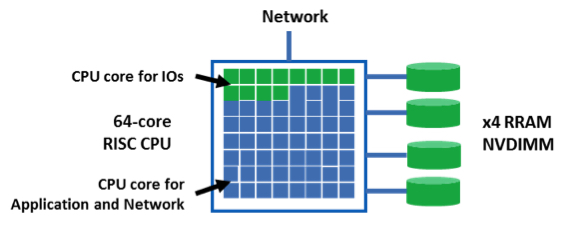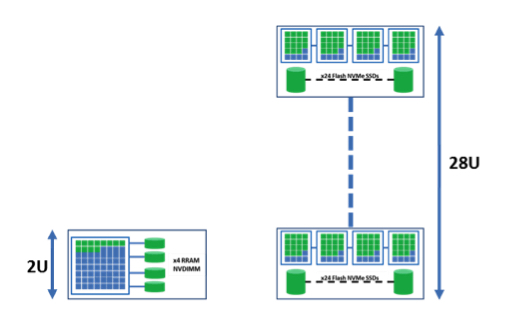Hyperconverged Infrastructure Virtualization With RRAM
By Sylvain Dubois, VP strategic marketing and business development, Crossbar
This is a Press Release edited by StorageNewsletter.com on August 23, 2016 at 3:07 pmHyperconverged Infrastructure Virtualization with RRAM
 By Sylvain Dubois, VP strategic marketing and business development, Crossbar, Inc., in Resistive RAM (RRAM) technology
By Sylvain Dubois, VP strategic marketing and business development, Crossbar, Inc., in Resistive RAM (RRAM) technology
The dream of converged infrastructure is here – with hardware integration of networking, compute and storage subsystems into a single box for data centers. With this integration, comes the promise to minimize compatibility and maintenance issues, and reduce total costs by eliminating cabling, cooling, and reducing power consumption and floor space.
As the hardware integration has taken off, now vendors are offering a more software-defined approach by integrating a software hypervisor that provides a virtualization of the three integrated functions of networking, compute and storage. This evolution is called hyper-converged infrastructure. While further delivering on the promise of integration, the hyper-converged infrastructure changes the scale out dynamic – because the basic elements of compute and storage can not scale independently anymore. As a result scale out is achieved by adding a new node, which introduces new bottlenecks.
Hyperconverged applications require multi-million IO/s storage performance due to the intensive I/O workload. And yet current SSD technologies based on NAND flash memory introduce significant latency, at 100μs to 200μs for a read I/O. To overcome the limitations of NAND flash, IT architects developed techniques such as massive parallelization and distributed workload to compensate for those limitations by having storage accesses split across multiples NAND flash components. Now that the servers are moving towards hyper-convergence, it will become very challenging to hide the inherent limitations of NAND flash to the application level.
New technologies such as RRAM are coming into the market that will slash latency to less than 10μs, resulting in new products such as NVMe SSDs. Latencies will drop even further if designers use the memory bus as the physical interface rather than PCIe. Devices that leverage the memory bus will be called NV-DIMMs, providing latencies in the microsecond range.
While the substantial performance and power benefits of RRAM can address the storage part of the equation, this new product category will require a fresh look at the CPU/compute side as well. As system resources continue to be consumed by the storage I/O, a new architecture will be necessary to ensure compute capabilities are adequate for the application and network interface while keeping power consumption low and bandwidth high.
An example of this is below. The bottleneck is on the compute/storage where most of the resources are used for the storage IO/s, and then there are not enough computing capabilities for the application and for the network interface. About 3.3 cores running at full time in a high end CPU are required to manage 1 million IO/s with NVMe devices, which is an expensive power and cost budget. A typical 2U server integrates 24 SSDs, that leads to 18 million IO/s using 750 IO/s SSDs assuming the application require a high queue depth. Therefore, 18×3.3 = 60 cores are required for the IO management, which is 75% of the resources of a high-end 4-CPU-based architecture as illustrated in figure 1. In case the IO/s need to go over the network, the related throughput is in the range of 18 million x 4,096 x 8 = 600Gb/s, which corresponds to 15 40GbE ports.
Figure 1: 18 million IO/s flash-based NVMe storage system
The use of RISC CPU provides enough computing capabilities for the I/O management, while keeping a low -power consumption and enough bandwidth for the application and network driver. The combination of the Crossbar RRAM, through NVMe or NV-DIMM storage devices, and RISC CPUs, provides the solution in term of IO/s and power consumption. Assuming that RISC CPU will be available in a reasonable power budget with 64 cores and 4 memory channels, we can estimate that an hyperconverged node can reach 12.5 million IO/s within a 100W power budget (figure 2). Because accessing a DIMM interface is simpler than a PCIe device, we can estimate that the storage software driver will be faster to execute compare to NVMe driver, leading in 1 million IO/s per core for the I/O management. Due to the small form factor, about 20 of such nodes could be integrated in a 2U chassis, leading to 250 million IO/s 2U hyperconverged server, with a 2kW power budget.
Figure 2: 12.5 million IO/s hyperconverged node
In this case, getting the IO/s over the network represents a very high bandwidth: 250 million x 4,096 x 8 = 8Tb/s, even if only 18% of the CPU resources are used for the IO management.
Coming back to the user level, as an example of a virtualization use case, such server can execute 83,000 VMs in parallel (3,000 IO/s/VM). In a current flash-based 2U hyperconverged server, integrating 24 2.5″ SSDs at 750,000 IO/s per SSD, only 6,000VMs can be executed, then 14 servers are needed to execute the same VM number. RRAM provides about 15x improvement for the I/O performance density (up to
125 million IO/s/U), and performance efficiency (125,000 IO/s/W) at server level.
Figure 3: 83,000 VMs on hyperconverged servers
In other words, for the same VM number, the users will benefit from a reduced TCO due to a more integrated solution delivering the same performance with less space, less power and less software licenses.
RRAM addresses the server design challenges. Low-latency/low-power storage subsystems based on this new storage class memory removes the bottleneck from the compute/storage side.

R&D efforts are required in compute/network side to get network interfaces in the few Tb/s range, and on the software side in order to reduce the storage driver execution time where the Crossbar RRAM enables smaller IO (512B), which can be used in big data analytics and OLTP data base applications, leading to 1G IO/s per U in server.












 Subscribe to our free daily newsletter
Subscribe to our free daily newsletter
